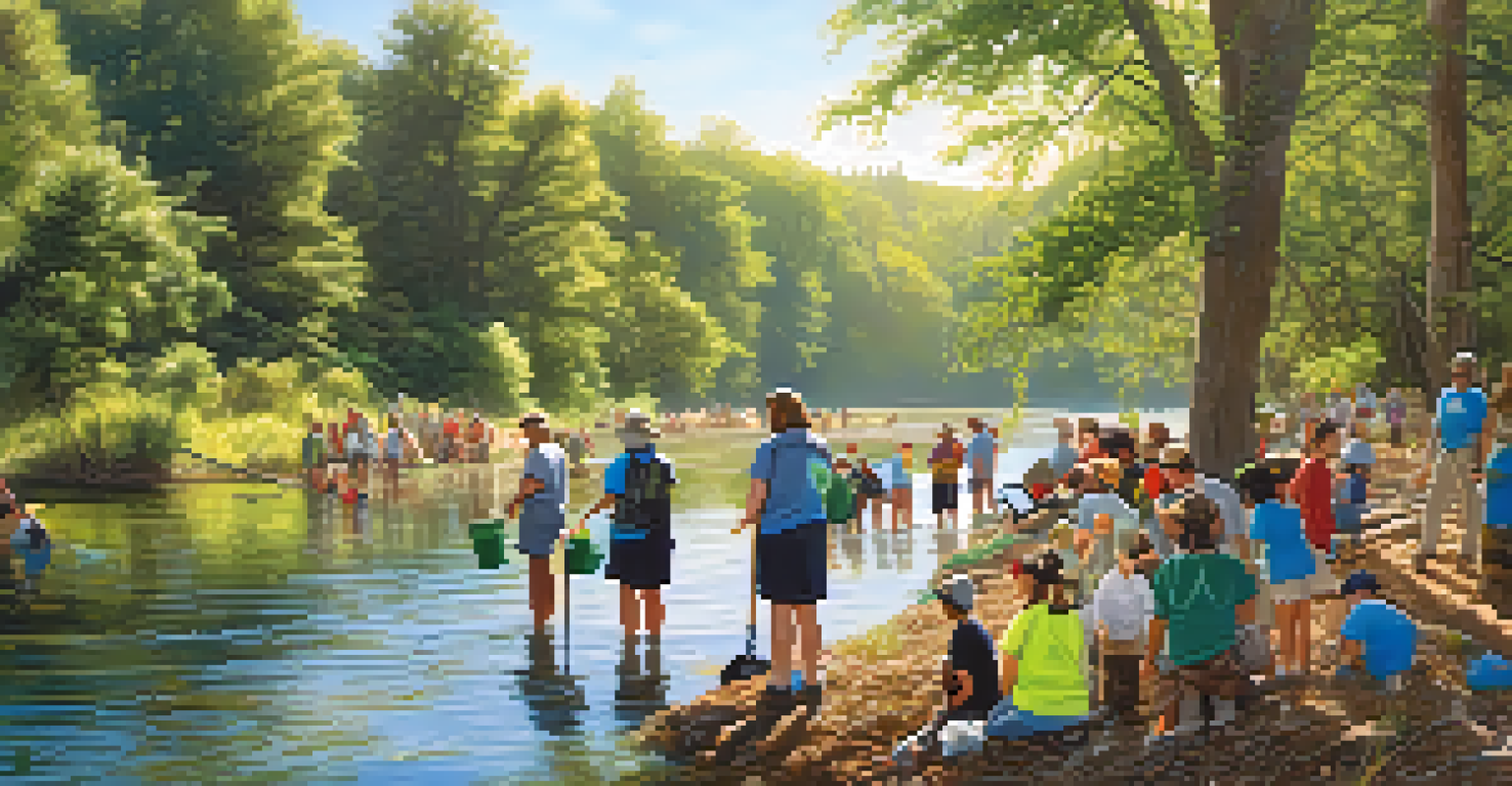Florida's Freshwater Springs: Biodiversity and Conservation Needs

Introduction to Florida's Unique Freshwater Springs
Florida is renowned for its stunning freshwater springs, which are natural wonders that attract thousands of visitors each year. These springs are formed when groundwater flows to the surface, creating crystal-clear pools that are both beautiful and vital to the ecosystem. They serve as habitats for diverse wildlife and provide recreational opportunities for locals and tourists alike.
The environment is where we all meet; where we all have a mutual interest; it is the one thing all of us share.
The springs are not just picturesque; they play a crucial role in maintaining the health of Florida's waterways. They contribute to the aquifer system, which supports drinking water supplies for millions of residents. Additionally, the springs are essential for sustaining the rich biodiversity found in Florida's ecosystems, making their protection imperative.
However, these natural treasures face numerous threats, including pollution, over-extraction of water, and habitat destruction. Understanding the importance of these ecosystems is the first step toward ensuring their conservation for future generations.
The Rich Biodiversity of Freshwater Springs
Florida's freshwater springs are home to an incredible array of plant and animal species, many of which are endemic, meaning they can only be found in this region. From the vibrant aquatic plants that thrive in the spring waters to the various fish species, including the endangered Florida manatee, these ecosystems are teeming with life. This biodiversity is not only beautiful but also essential for ecological balance.

The springs provide critical habitats for many organisms, including amphibians, reptiles, and a variety of bird species. For instance, the springs support the survival of species like the Eastern Indigo Snake and the Florida Sandhill Crane, both of which rely on these environments for breeding and feeding. The intricate web of life within these springs highlights the interconnectedness of nature and the importance of conservation efforts.
Florida Springs' Ecological Importance
Florida's freshwater springs are vital ecosystems that support diverse wildlife and provide essential drinking water for millions.
Unfortunately, the biodiversity of these springs is under threat from invasive species, which can disrupt the delicate balance of the ecosystem. Protecting the native species and their habitats is vital for maintaining the health of Florida's freshwater springs.
Threats Facing Florida's Freshwater Springs
Despite their ecological importance, Florida's freshwater springs face significant threats that jeopardize their health and sustainability. One of the primary challenges is pollution from agricultural runoff, urban development, and wastewater discharge. These pollutants can lead to harmful algal blooms, which deplete oxygen levels and harm aquatic life.
In every walk with nature, one receives far more than he seeks.
Water extraction is another critical issue, as excessive pumping can lower water levels and degrade the quality of the springs. This over-extraction often occurs to meet the growing demand for water in Florida's rapidly expanding population. As a result, many springs are seeing reduced flow rates, impacting the entire ecosystem that relies on their consistent output.
Climate change also poses a growing threat, leading to altered rainfall patterns and increased temperatures. These changes can further stress the delicate balance of life in the springs and exacerbate the existing challenges. It is essential to address these threats through thoughtful conservation and management strategies.
Conservation Efforts for Freshwater Springs
Recognizing the urgent need for action, various organizations and government agencies have stepped up to protect Florida's freshwater springs. Initiatives include habitat restoration, pollution reduction programs, and public education campaigns aimed at raising awareness about the importance of these ecosystems. Through collaborative efforts, stakeholders are working to ensure that these natural resources are preserved for future generations.
One successful example is the Springs Protection Act, which aims to safeguard the water quality and flow of springs throughout the state. The act provides funding for restoration projects and encourages sustainable practices that minimize environmental impact. Additionally, local communities are becoming increasingly involved in conservation efforts, emphasizing the significance of grassroots activism.
Threats to Freshwater Springs
Pollution, over-extraction, and climate change pose significant threats to the health and sustainability of Florida's springs.
Engaging the public is crucial for the long-term success of conservation initiatives. By promoting a deeper understanding of the springs' ecological importance, communities can rally together to take action, whether through clean-up events or advocating for policy changes that prioritize environmental health.
The Role of Education in Conservation
Education plays a pivotal role in fostering a culture of conservation around Florida's freshwater springs. Schools and organizations are developing programs that teach students about the unique ecosystems found in their own backyards. These educational initiatives empower the next generation to appreciate and protect their natural resources.
Field trips to local springs provide hands-on learning experiences, helping students connect with nature and understand the delicate balance of life within these ecosystems. By witnessing the beauty and complexity of freshwater springs firsthand, young people are more likely to become advocates for conservation efforts in the future.
Moreover, public awareness campaigns can further educate adults about the importance of protecting these springs. Workshops, seminars, and community events can highlight the actions individuals can take to reduce their impact on the environment, fostering a collective responsibility towards conservation.
Community Involvement in Protecting Springs
Community involvement is crucial for the success of conservation efforts surrounding Florida's freshwater springs. Local residents can play an active role in protecting these ecosystems by participating in clean-up initiatives, restoration projects, and educational programs. When communities come together to care for their natural resources, the impact can be significant and lasting.
Collaborative efforts often lead to stronger advocacy for policies that prioritize environmental health and sustainable practices. By organizing community forums and discussions, residents can voice their concerns and work together to find solutions to challenges facing their springs. The combined efforts of passionate individuals can create a powerful force for change.
Community Engagement in Conservation
Active community involvement and education are crucial for the successful conservation of Florida's precious freshwater springs.
Furthermore, engaging local businesses in conservation efforts can create a culture of sustainability within the community. By promoting eco-friendly practices, businesses can support the health of freshwater springs while also attracting environmentally conscious customers. This symbiotic relationship benefits both the environment and the local economy.
Conclusion: The Future of Florida's Freshwater Springs
The future of Florida's freshwater springs lies in our hands. By understanding the significance of these ecosystems and the threats they face, we can take meaningful steps toward their preservation. Conservation efforts, community involvement, and education are all vital components in ensuring that these natural treasures thrive for generations to come.
As we face ongoing challenges like climate change and pollution, it's crucial to remain vigilant and proactive in our conservation strategies. Continued collaboration among stakeholders, including government agencies, non-profits, and local communities, will be essential in addressing these issues effectively. Together, we can work towards sustainable solutions that protect the health of our springs.

Ultimately, the beauty and biodiversity of Florida's freshwater springs are worth fighting for. By fostering a culture of conservation and encouraging active participation, we can ensure these natural wonders remain vibrant and accessible for all who wish to enjoy their splendor.